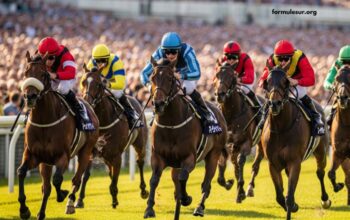Turf betting, a popular pastime among racing enthusiasts, involves predicting the outcome of horse races. One tool that seasoned bettors use to gain an edge is the “Indice de Forme.” This French term, translating to “Form Index” in English, plays a crucial role in analyzing a horse’s performance and making informed betting decisions.
In this article, we’ll explore what the Indice de Forme is, how it is calculated, and how you can leverage it to enhance your betting strategy.
What is the Indice de Forme?
The Indice de Forme (IF) is a numerical value used to evaluate a horse’s recent performance and overall form. Essentially, it’s a form index that helps bettors gauge the current competitiveness of a horse in upcoming races.
The higher the IF, the better the recent form of the horse, indicating a higher likelihood of a strong performance.
How is the Indice de Forme Calculated?
The Indice de Forme is calculated based on a combination of factors from a horse’s previous races. While the specific methodology can vary between different racing organizations and betting platforms, the general approach involves the following steps:
- Recent Performance Analysis: The IF calculation starts with a horse’s recent race results. The horse’s finishing positions, times, and the quality of opponents are considered. Typically, performances in the last 5 to 10 races are analyzed to get a clear picture of the horse’s current form.
- Race Conditions Adjustment: Adjustments are made based on race conditions such as track surface, distance, and weather. A horse that performs well on soft ground but poorly on firm ground will have its form adjusted accordingly to reflect these nuances.
- Weight and Distance Consideration: The index takes into account the weight carried and the distance raced. Horses running with higher weights or over longer distances may see their performance impact adjusted in the index.
- Quality of Competition: The level of competition in previous races is also factored in. A horse that consistently finishes in the top positions in high-quality races will typically have a higher IF.
- Consistency: The consistency of a horse’s performance plays a significant role. A horse that consistently performs well, even if not winning every race, will have a higher IF compared to one with sporadic strong performances.
Interpreting the Indice de Forme
Understanding and interpreting the Indice de Forme requires some insight into how the index translates into betting strategy:
- High Indice de Forme: A high IF indicates that the horse is in excellent form, suggesting a higher chance of performing well in its next race. Bettors should consider such horses for potential wins or strong showings.
- Moderate Indice de Forme: A moderate IF may suggest that the horse is in decent form but not outstanding. These horses could be considered for place bets or exotic bets where they finish in the top positions but may not necessarily win.
- Low Indice de Forme: A low IF indicates poor recent performance or inconsistent results. Such horses are generally less reliable for winning bets, but they might present value in exacta or trifecta bets if you’re looking for potential upsets.
Practical Application of the Indice de Forme in Betting
To effectively use the Indice de Forme in your betting strategy, consider the following practical tips:
- Combine with Other Factors: While the IF is a valuable tool, it should not be used in isolation. Combine it with other factors such as jockey performance, trainer statistics, and track conditions to make a well-rounded betting decision.
- Track Record Analysis: Look at the horse’s performance over a variety of track conditions and distances. A horse with a high IF in specific conditions might perform differently under varying circumstances.
- Historical Data Review: Analyze historical data and trends associated with horses that have had similar IF scores. This can provide additional insights into how horses with comparable forms have performed in the past.
- Betting Market Dynamics: Be aware of how the IF influences the betting market. A horse with a high IF might attract heavy betting, impacting odds. Balancing your bets between horses with high and moderate IFs can be a strategic approach.
- Value Betting: Use the IF to identify potential value bets. Sometimes, a horse with a moderate or low IF might be overlooked by the betting public, presenting an opportunity for value betting if you believe the horse has the potential to outperform its expected performance.
Common Mistakes to Avoid
When utilizing the Indice de Forme, bettors should be mindful of common pitfalls:
- Overreliance: Relying solely on the IF without considering other factors can lead to poor betting decisions. Always incorporate a holistic approach.
- Neglecting Race-Specific Conditions: Failing to adjust the IF based on specific race conditions can skew your analysis. Ensure that you consider all relevant factors.
- Ignoring Trends: Not keeping an eye on changing trends and conditions in the racing world can lead to outdated or inaccurate use of the IF.
- Disregarding Jockey and Trainer Influence: The impact of jockeys and trainers on a horse’s performance can be significant. Don’t overlook these factors when evaluating the IF.
Conclusion
The Indice de Forme is a powerful tool for assessing a horse’s recent performance and predicting future outcomes in turf betting.
By understanding how it is calculated and how to interpret it, bettors can gain valuable insights into a horse’s form and make more informed betting decisions.
Remember to use the IF as part of a broader strategy that includes evaluating other performance indicators, race conditions, and market dynamics.
With careful analysis and a strategic approach, you can enhance your betting strategy and improve your chances of success in the thrilling world of turf betting.







